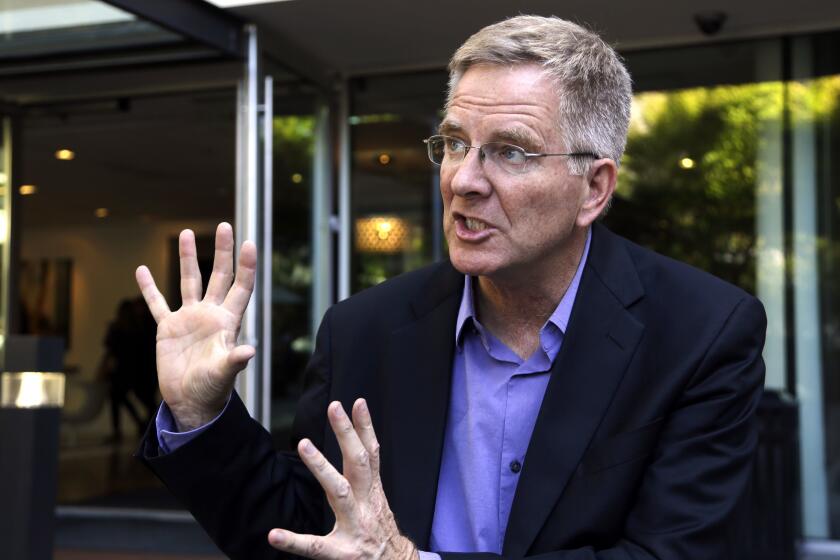The Fun Zone: Are We Having History Yet?
Two distinct odors waft over the Ferris wheel at Balboa’s Fun Zone: saltwater and cotton candy.
They are smells that intersect at only a handful of places, where oceans and carnivals meet. This is such a place, anchored by Newport Beach’s historic Balboa Pavilion, its familiar blue cupola towering as a beacon of an era past.
“It’s like a step back in time,” says Laurie Davis, 49, of nearby Corona del Mar. She rides the ferry here regularly so her 11-year-old son can play games in the arcade and enjoy the carousel. “This place hasn’t changed in a lot of years. Before there was Fashion Island or anything else, the Fun Zone was here.”
Not before the pavilion, however. Built in 1905, the large, open-air building, with a Victorian-era balustrade edging its second floor, served as the southern terminus for the old Pacific Electric Railway, which brought passengers from downtown Los Angeles to the beach in less than an hour. It also served as the bathhouse where the crowd, whose numbers swelled each summer, could change clothes before and after a swim.
“It was a pretty slick deal,” Bill Grundy, president of the Newport Beach Historical Society, says of the pavilion. The building, designated a state historic landmark, is one of California’s last surviving examples of the great waterfront recreational pavilions from the turn of the 20th century.
Grundy, 87, recalls the structure from childhood. “It was kind of a congregating place. People used to wear hats and their Sunday clothes to the beach, then change into these crazy outfits -- bathing suits all made of wool. This building started Balboa.”
After the dismantling of the railroad in the 1930s, Grundy says, the pavilion had a series of reincarnations as, among other things, the city’s first dance hall, a post office, bowling alley, arcade and art museum. Today it houses a restaurant, banquet hall, sportfishing shop and Catalina Island ticket office. And its cupola appears on charts as a visual aid for mariners navigating Newport Harbor.
As the pavilion evolved, so did the neighborhood it defined. From its beginnings as a community in 1906, Balboa Peninsula was linked to Balboa Island by ferry service that first consisted of rowboats departing every half hour.
In 1919, the service was “modernized” and taken over by the same family that runs it today. Summer crowds included lots of children, who needed entertaining. Nobody seems sure exactly how or when it started, Grundy says, but someone thought of offering carnival rides. And so began the Fun Zone, which Grundy and others believe is Southern California’s oldest surviving amusement park.
That idea suited the tourists and locals just fine one recent Sunday afternoon as they moved along the sparkling waterfront feeding pigeons, buying T-shirts, eating hot dogs or frozen bananas and standing in line to try the spook house and the bumper cars.
“I like to watch the people walking around,” said Gene Altobello, 54, a peninsula resident sporting a gray beard and ponytail who comes to the Fun Zone nearly every day. “I get the feeling that it’s still back when I was young -- the place has changed very minimally since it started.”
Tracy Buck, 38, a caricature artist who’s been selling his original made-to-order cartoon portraits here for 15 years, said the crowd -- and his business -- has dropped about 50% in recent years because of increasing competition from modern malls, such as Newport Beach’s Fashion Island, the Block at Orange and the Irvine Spectrum.
“It used to be a lot better,” he said. “Fifteen years ago, if you wanted to go someplace at night, this was the place to go, but not anymore.”
Patricia Zusy, though, finds the Fun Zone a welcome change from all that mall culture.
“You get a sense of family here, and that’s a good thing,” said Zusy, 32, who moved to Orange County from Northern California three months ago with her husband and year-old son. “It provides something different to entertain the little guy.”
Then there are the regulars, for whom the smell of cotton candy and the sight of the cupola connote the comforts of home and tradition. “There’s a lot of history here,” said Chante Boeke, 33, who lives on Balboa Island and roller-blades over here almost daily. “It gives you a sense of community.”
For Kevin Tilden, 36, the place still evokes the season of its origins:
“It always feels like summer when you’re down here,” he said. “And I’ve spent lots of summers down here.”
Sign up for The Wild
We’ll help you find the best places to hike, bike and run, as well as the perfect silent spots for meditation and yoga.
You may occasionally receive promotional content from the Los Angeles Times.



